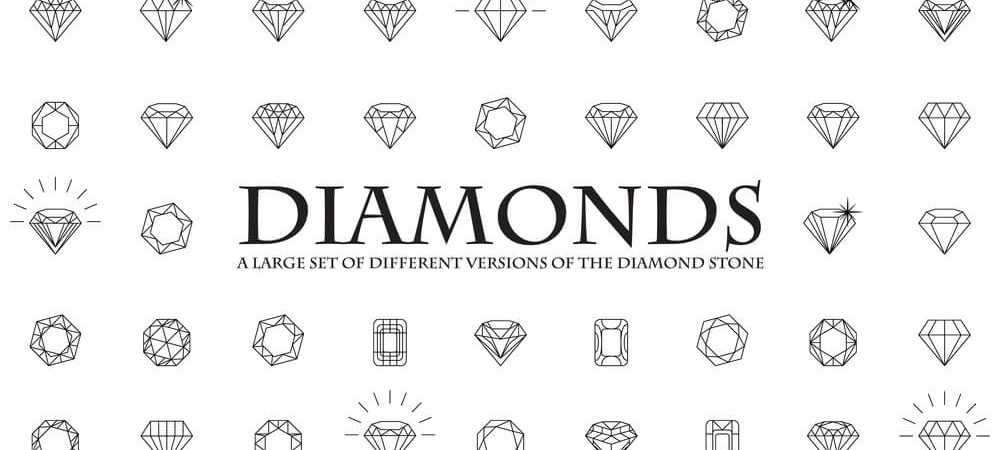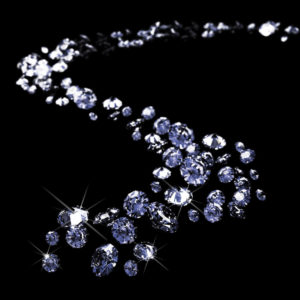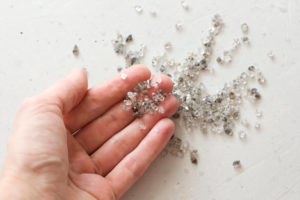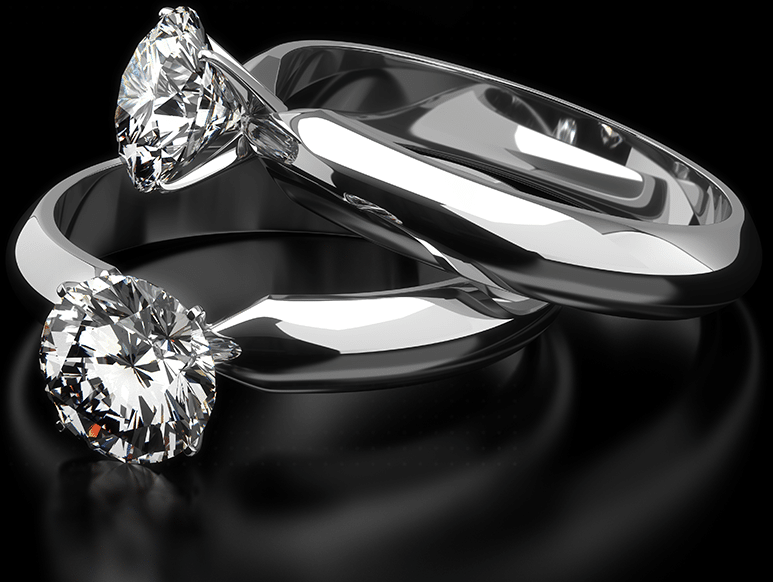Glossary of Diamond Terms and Definitions
-
Shira-Diamonds
-
0 Comment
The diamond terms explained below are general diamond terminology so you can be guided by the usual diamond lingo used when you will sell, buy, describe or customize a diamond.
Diamond abbreviations are also explained such as the usual diamond shape abbreviations jewelers used.
General Diamond Terms
- 4C’s – Cut, Color, Clarity, and Carat are the four Cs of diamonds.
- AGS GRADING SCALE – Evaluations are graded on a scale of 0 to 10, with 0 being the ideal or “zero deductions.” Color and clarity are also evaluated on a numerical scale in addition to cut quality, but the GIA equivalents are also given in the report.
- BLEMISH – is an imperfection on the surface of a diamond that may or may not be visible.
- BRILLIANCE – The effect generated by light returns when brightness and positive contrast are combined.
- BRILLIANT – A cutting technique with vertical triangle or kite-shaped facets radiating from a central point. This facet type, which gives in a considerably different ‘flavor’ than step cuts with strong horizontal facets, is exemplified by the round brilliant and princess cut.
- CARAT – A unit of weight. Diamond size is commonly linked to a carat weight, however, depending on cut proportions, diamonds can have the same weight but drastically different dimensions.
- CERTIFICATE – A gemological laboratory report.
- CERTIFIED GEMOLOGIST (AGS) – A student who has completed both the GIA graduate gemology program and the AGS diamond program and is employed by an AGS member store is given this credential.
- CLARITY – The amount of internal inclusions and outward imperfections in a diamond. Laboratory clarity grading is performed by professional graders at a magnification of 10X.
- CLOUD – is a little inclusion in a diamond.
- COLOR – The color of one’s skin. Diamonds in the typical range are graded D-Z based on how much yellow or brown body color they have. The diamond is color graded in a laboratory by comparing it to known master sets of diamonds.
- CUBIC ZIRCONIA (CZ) – is the most widely used lab-grown imitation diamond (simulant) nowadays.
- CUSHION – A cushion is a square or rectangular object with rounded corners. Cushion-cut diamonds are sometimes known as antique cushion diamonds.
- CUT – Aspects of the final diamond’s proportioning and polishing. Cut quality has a greater influence on light performance and attractiveness than any other factor. The term ‘cut’ can also refer to the form of something, such as an emerald cut.
- DISPERSION – The prismatic separation of white light into its distinct color components. Fire is the name given to the colorful sparks created by the crown.
- EYE-CLEAN – A diamond with no apparent flaws or blemishes when seen with the naked eye.
- FACET – A completed gem’s flat polished surface.
- FIRE – is colored light that is reflected from the inside and radiates forth.
- FLUORESCENCE – An luminous bluish hue that glows from the diamond surface when exposed to UV light, which typically has little effect on appearance or quality.
- GIA (Gemological Institute of America) – The world’s most well-known and recognized gemological laboratory, GIA developed the color and clarity grading systems used by the international diamond industry.
- HOLLOWAY CUT ADVISOR (HCA) – is a simple online application that uses a few basic parameters to offer some indicators of future performance.
- IDEAL CUT – An ideal cut diamond is a properly proportioned round diamond.
- IRRADIATION – A treatment procedure that involves blasting a diamond with radiation to change its hue.
- KEYS TO SYMBOLS – Identifies the stone plot’s features in order of their influence on the clarity grade.
- LASER DRILLING – Laser drilling is a technique for improving apparent clarity by creating a small hole in a diamond to vaporize an inclusion or allow acid to dissolve it.
- MARQUISE – Faceting in the dazzling style that is elongated and has points on both ends.
- MOISSANITE – is a contemporary diamond simulant with good hardness and dispersion. It can deceive thermal conductivity sensors that are commonly used to detect CZ and other stimulants. It is, nevertheless, doubly refractive, making it visible to the trained eye.
- OLD MINE CUT – A squarish shape, tiny table, and big culet distinguish this early diamond cut.
- OVAL – An elongated brilliant style cut with rounded edges.
PAVÉ – A jewelry method in which tiny diamonds are placed very close together to produce a solid field of diamonds, similar to a stone-paved road. A jeweler working under a microscope is usually responsible for micro pavé.
- PEAR – Also known as a teardrop, this form has a point on one end and a rounded shape on the other and is carved brilliantly.
- PRINCESS – Pavilion is a square to slightly rectangular form with dazzling elegance.
- RADIANT – An octagonal shape formed by a square or rectangle cut with clipped corners.
- RHINESTONE – An early imitation diamond made by painting a reflecting paint on the reverse of cut glass. It has long been popular in costume jewelry, and is frequently referred to by the old fashion word “paste.”
- ROUND BRILLIANT – The traditional round cut diamond form with large triangular facets on the pavilion.
- SINGLE CUT – A circular form with fewer facets — nine on the crown, including the table, and eight on the pavilion, with or without a culet facet. In antique jewelry, this is a common design for accent stones.
- SPARKLE – is the amount of reflected light that radiates from the surface of a diamond and combines both fire and brightness.
- SYNTHETIC DIAMOND — Synthetic diamond is a lab-grown product with the same physical and optical characteristics as real diamond.
- TABLE CUT – An early diamond cut that included grinding off one point of an octahedral diamond crystal to create a big flat facet on top (table) while leaving the rest of the natural crystal faces intact.
- TRILLIANT – triangle facet arrangement in dazzling design.
- TRIPLE ZERO – The AGS Ideal cut grade is referred to as triple zero. It was originally a reference to an AGS 0-10 scale D Flawless Ideal cut. It became shorthand for an Ideal Cut with proportions of 0, polish of 0, and symmetry of 0. Despite the addition of the fourth criteria for Ideal – light performance – the certificate is still known as Triple Zero.
- VIRTUAL FACET – Because a single facet may reflect light from numerous sources, a diamond creates more individual sparkles than there are real facets. Virtual facets are the names given to these distinct light occurrences.
- WEIGHT RATIO – A calculation of a diamond’s total weight in proportion to its diameter is called a weight ratio.
We hope you find this list of diamond terminology helpful, but if you don’t find what you’re searching for, please don’t hesitate to contact us at Shira Diamonds.
More from Shira Diamonds
How Much is 1 Carat Loose Diamond?
Why Is the Resale Value of a Diamond So Low?









 PAVÉ – A jewelry method in which tiny diamonds are placed very close together to produce a solid field of diamonds, similar to a stone-paved road. A jeweler working under a microscope is usually responsible for micro pavé.
PAVÉ – A jewelry method in which tiny diamonds are placed very close together to produce a solid field of diamonds, similar to a stone-paved road. A jeweler working under a microscope is usually responsible for micro pavé.



